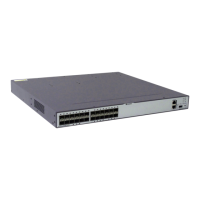The system view is displayed.
2. Run:
isis [ process-id ]
An IS-IS process is created, and the IS-IS process view is displayed.
3. Run:
is-level { level-1 | level-1-2 | level-2 }
The level of the switch is configured.
l (Optional) Configure IS-IS host name mapping.
1. Run:
system-view
The system view is displayed.
2. Run:
isis [ process-id ]
An IS-IS process is created, and the IS-IS process view is displayed.
3. Run:
is-name symbolic-name
IS-IS dynamic host name mapping is configured. The system ID of the local device
is mapped to the specified host name.
The value of symbolic-name is contained in LSP packets and advertised to other IS-
IS devices.
On another IS-IS device displays the value of symbolic-name, but not the system ID,
of the local IS-IS device.
4. Run:
is-name map system-id symbolic-name
IS-IS static host name mapping is configured. The system ID of a peer IS-IS device
is mapped to the specified host name.
This command configuration takes effect only on the local IS-IS device. The value of
symbolic-name will not be added to LSP packets.
If dynamic host name mappings is configured on an IS-IS network, the mappings on
the network overwrite the mappings configured on the local switch.
l (Optional) Enable the output of the IS-IS adjacency status.
1. Run:
system-view
The system view is displayed.
2. Run:
isis [ process-id ]
An IS-IS process is created, and the IS-IS view is displayed.
3. Run:
log-peer-change
The output of the adjacency status is enabled.
----End
S6700 Series Ethernet Switches
Configuration Guide - IP Routing 6 IS-IS Configuration
Issue 01 (2012-03-15) Huawei Proprietary and Confidential
Copyright © Huawei Technologies Co., Ltd.
245

